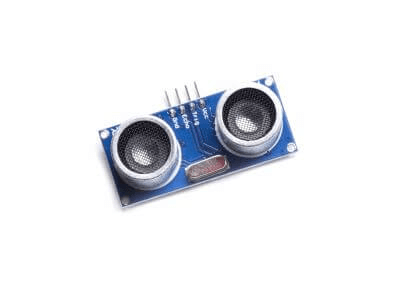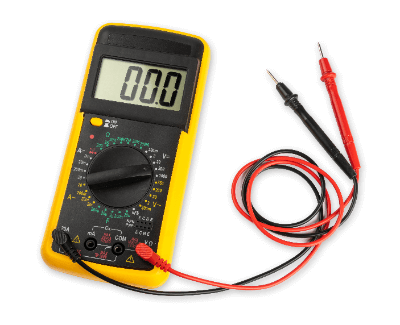What Is an Oscilloscope?
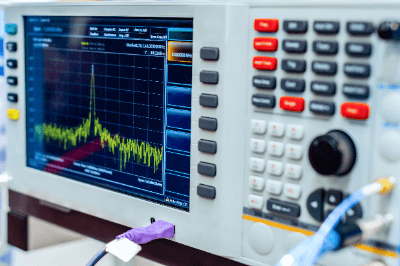
An oscilloscope is an instrument that outputs electrical signals as waveforms on a screen, and is characterized by the ability to observe signal changes over time in two dimensions.
Oscilloscopes are broadly classified into analog oscilloscopes and digital oscilloscopes.
1. Analog Oscilloscopes
Analog oscilloscopes observe input signals by scanning an electron beam over the tube surface of a cathode-ray tube to draw waveforms. The input signal to the oscilloscope is immediately displayed with a short delay.
2. Digital Oscilloscopes
Digital oscilloscopes convert input signals into digital data using an A/D converter, store the data in memory, and then display the waveforms on a display. Unlike analog oscilloscopes, data collection is discrete, so data is complementary and displays as a smooth curve.
Uses of Oscilloscopes
Oscilloscopes display electrical signals as waveforms, allowing you to visually check the operation of electronic circuits. By using an oscilloscope, it is possible to check the signal waveforms in an electronic circuit and verify that the circuit is operating as intended.
When verifying high-speed digital circuits, signals must be captured with reliable timing that is not affected by digital signal fluctuations (jitter), and oscilloscopes are used to set the timing.
Oscilloscopes are also useful in repairing electronic equipment because they can trace the signal waveforms of various parts of an electronic circuit to locate the faulty part if the cause of the equipment failure is in the electronic circuit.
Principle of Oscilloscopes
In a conventional analog oscilloscope, the signal input from the probe is transmitted to the oscilloscope’s vertical amplification circuit. The signal is attenuated or amplified in the vertical amplifier circuit and then transmitted to the vertical deflector plate of the cathode-ray tube.
The voltage applied to the vertical deflector plate scans the electron beam up and down. This sequence of events is the principle behind oscilloscopes. The input signal is simultaneously transmitted to the trigger circuit, and the electron beam starts scanning horizontally the moment the signal matches the set trigger condition.
In a digital oscilloscope, the input signal is converted to digital data by an A/D converter, and the data is sequentially stored in memory. Then, after a predetermined period has elapsed from the point when the input signal meets the trigger condition, it stops storing new data.
As a result, the above memory records the signals before and after the timing when the trigger condition is met, and these signals are displayed as waveforms on the display. In other words, signal waveforms before the trigger can also be observed.
The data in the memory can also be used for waveform analysis, e.g., frequency analysis of signals by FFT operation. Furthermore, the data can be output to a memory card for analysis and data storage on a PC.
How to Select an Oscilloscope
When selecting an oscilloscope, it must have sufficient specifications for the application. Specifically, frequency response, sampling rate, number of channels, memory length, and available probe types should be considered.
In addition to the basic use of oscilloscopes for observing waveforms, current oscilloscope applications are expanding to include timing verification, waveform analysis, and compliance testing, and the measurement range and functionality are increasing accordingly. As a result, there is a need to select a model with functions suitable for the intended use.
How to Use an Oscilloscope
In addition to observing voltage variations over time, oscilloscopes can also measure the frequency of repetitive signals and draw Lissajous curves. Oscilloscopes are widely used for testing electronic circuits, waveform visualization of video and audio signals, testing response characteristics of power devices, measuring the timing margin of high-speed digital circuits, and evaluating mechatronics products.
Preparation for measurement includes phase adjustment of probes and skew adjustment between probes. Especially when current and voltage probes are used together, skew adjustment is essential because of the significant delay time of current probes. One should also wait about 30 minutes after power-on before measuring to ensure sufficient measurement accuracy.
The trick to observing the desired waveform is to adjust the trigger. With analog oscilloscopes, the only adjustment factors are slope selection, trigger level, and trigger delay, but with digital oscilloscopes, in addition to these factors, various trigger conditions, such as pulse width and interval, can be set.
Additionally, sequential triggers, which capture signals when multiple trigger conditions are satisfied, are also available.
Other Information on Oscilloscopes
1. Features and Differences Between Analog and Digital Oscilloscopes
The features of both types of oscilloscopes can be summarized as follows:
Analog Oscilloscope
- Excellent real-time performance and short dead time between capturing and displaying a new signal.
- The frequency of occurrence of the same waveform can be determined by the brightness of the signal.
- Not suitable for observation of one-shot phenomena or phenomena that are not frequently repeated.
- Requires photographic equipment to save observation results.
- Analysis using waveforms is not possible.
Digital Oscilloscope
- The supplemental display of one-shot phenomena is possible.
- Observation results can be handled as electronic data for easy storage.
- Waveforms can be handled as digital data and analyzed by a processor.
- Long dead time for signal processing, so actual observation time is relatively short.
- Waveform frequency information is lost in repetitive waveforms.
Today, there are no analog oscilloscopes available for industrial measurement applications, and digital oscilloscopes are the choice for almost 100% of applications.
This is possible because of readily available high-speed A/D converters and processors for waveform processing, along with tech improvements that address digital oscilloscope limitations, resulting in affordable, highly functional products.
2. Points to Note About Oscilloscopes
There are several points to note when using an oscilloscope to observe correct waveforms. In particular, it is important to select a model with a frequency response that sufficiently covers the frequency band you wish to measure.
The frequency response of an oscilloscope is defined as the frequency at which the amplitude falls to -3 dB. So, for accurate amplitude measurement, a model with a frequency response of about 5 times the frequency of the signal under test should be selected.
Additionally, the data sampling frequency of a digital oscilloscope must also be taken into consideration. If the sampling frequency is less than twice the frequency of the signal under test, aliasing will occur and false waveforms will be displayed.

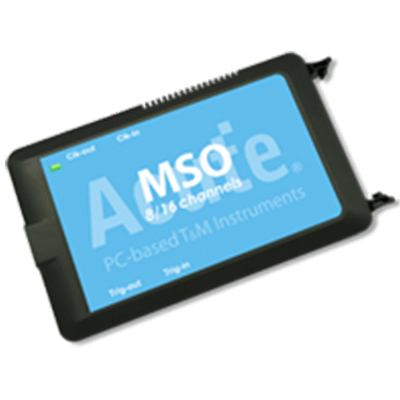 A logic analyzer is a device primarily used to verify the operation of digital circuits.
A logic analyzer is a device primarily used to verify the operation of digital circuits.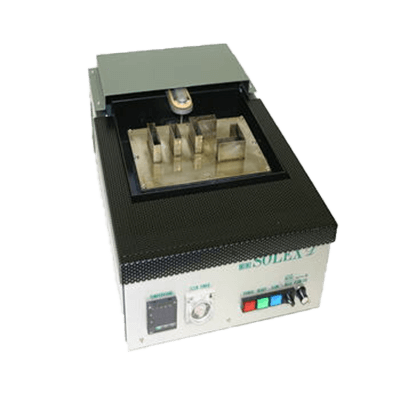 A solder pot is a container that holds or is filled with molten solder and equipped with a
A solder pot is a container that holds or is filled with molten solder and equipped with a 